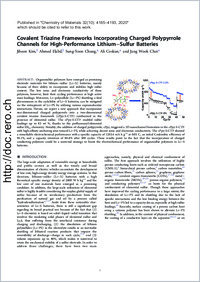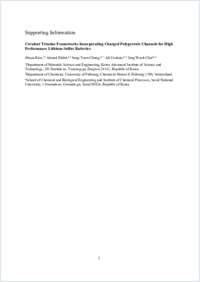Covalent triazine frameworks incorporating charged polypyrrole channels for high-performance lithium–sulfur batteries
- Kim, Jiheon Department of Materials Science and Engineering, Korea Advanced Institute of Science and Technology, 291 Daehak-ro, Yuseong-gu, Daejeon 34141, Republic of Korea
- Elabd, Ahmed Department of Chemistry, University of Fribourg, Chemin de Musee 9, Fribourg 1700, Switzerland
- Chung, Sung-Yoon Department of Materials Science and Engineering, Korea Advanced Institute of Science and Technology, 291 Daehak-ro, Yuseong-gu, Daejeon 34141, Republic of Korea
- Coskun, Ali Department of Chemistry, University of Fribourg, Chemin de Musee 9, Fribourg 1700, Switzerland
- Choi, Jang Wook School of Chemical and Biological Engineering and Institute of Chemical Processes, Seoul National University, 1 Gwanak-ro, Gwanak-gu, Seoul 08826, Republic of Korea
-
26.05.2020
Published in:
- Chemistry of Materials. - 2020, vol. 32, no. 10, p. 4185–4193
English
Organosulfur polymers have emerged as promising electrode materials for lithium– sulfur (Li–S) batteries, mainly because of their ability to incorporate and stabilize high sulfur content. The low ionic and electronic conductivity of these polymers, however, limit their cycling performance at high active mass loadings. Moreover, Li–polysulfide (Li–PS) shuttling, a fatal phenomenon in the cyclability of Li–S batteries, can be mitigated via the entrapment of Li–PS by utilizing various supramolecular interactions. Herein, we report a new approach that incorporates one-dimensional charged polypyrrole into a two-dimensional covalent triazine framework (cPpy-S-CTF) synthesized in the presence of elemental sulfur. The cPpy-S-CTF enabled sulfur loadings up to 83 wt %, thanks to the perfluoroaryl-elemental sulfur SNAr chemistry. Notably, the addition of charged polypyrrole, cPpy, triggered a 3D nanochannel formation in the cPpy-S-CTF with high-affinity anchoring sites toward Li–PS, while achieving decent ionic and electronic conductivity. The cPpy-S-CTF showed a remarkable electrochemical performance with a specific capacity of 1203.4 mA h g–1 at 0.05 C, an initial Coulombic efficiency of 94.1%, and a capacity retention of 86.8% after 500 cycles. These results point to the fact that the incorporation of charged conducting polymers could be a universal strategy to boost the electrochemical performance of organosulfur polymers in Li–S batteries.
- Faculty
- Faculté des sciences et de médecine
- Department
- Département de Chimie
- Language
-
- English
- Classification
- Chemistry
- License
-
License undefined
- Identifiers
-
- RERO DOC 328599
- DOI 10.1021/acs.chemmater.0c00246
- Persistent URL
- https://folia.unifr.ch/unifr/documents/308686
Other files
Statistics
Document views: 197
File downloads:
- pdf: 511
- Supplementary material: 211

